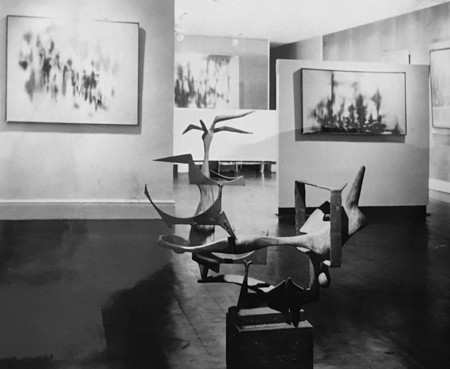A photograph by Aaron Siskind shows a day during the Artists’ Sessions at Studio 35, a three-day symposium hosted in 1950 by Alfred H. Barr Jr., Robert Goodnough, and Robert Motherwell dealing with the characteristics of a new abstraction. It spurred several of my predecessors (art historians and critics) to reintroduce the work of Norman Lewis (1909–1979) into the canon. Ann Gibson and others have related how they were struck by the inclusion of Lewis, a black man, at a table with the paradigmatic artists whom we categorize as associated with abstract expressionism: Adolph Gottlieb (1903–1974), Hans Hofmann (1880–1966), Willem de Kooning (1904–1997), Richard Lippold (1915–2002), Seymour Lipton (1903–1986), Motherwell (1915–1991), Barnett Newman (1905–1970), Richard Pousette-Dart (1916–1992), Ad Reinhardt (1913–1967), David Smith (1906–1965), and Hedda Sterne (1910–2011). In the photograph, Lewis, sitting among this group, manages to operate as both studium and punctum, socioculturally notable and striking because of the high contrast of his physical difference from the group.
In a manner akin to Gibson’s experience with the Artists’ Sessions
photograph, another photograph led me to reconsider Lewis’s relationship to midcentury abstraction: an installation view of his 1952 solo exhibition at the Willard Gallery. It provided insight into the relationship between Lewis and Smith, which is the basis of the first chapter of my dissertation. The installation photograph (and its subsequent reproduction in the gallery brochure) show what no other documentation of the exhibition details—that is, Smith’s sculpture in the foreground and Lewis’s paintings in the background. Through the Estate of David Smith, I was able to ascertain that the work is Smith’s Flight (1951).
This archival document (alongside many others) uncovered in the
Willard Gallery archives during my CASVA fellowship has allowed me a glimpse into the past. However, unlike the Artists’ Sessions photograph, which gives insight into a past in which Lewis’s black body is a fulcrum for discussing a reorganization of the abstract expressionist canon, the installation view is documentation of how we could potentially examine the work of two artists exploring abstraction at midcentury.
Lewis’s oeuvre has either been shoehorned into dialogue with that
of Jackson Pollock (1912–1956) or discussed as divorced from abstract expressionist circles. My work during the fellowship has centered on uncovering these object-oriented relationships in order to develop a new language and criteria for canonical art from the period. The Willard installation photograph allows me to circumvent the earlier revisionist questions of who Lewis is and why no one has examined what this black man was doing at the table alongside famous abstract expressionist artists. Instead, I am able to tackle what I believe at this juncture to be a far more interesting query: What, if anything, can we say about the work of these two artists that could productively unsettle the tidiness of the literature?
We know the two artists showed at the Willard Gallery and were
friends, but these casual relationships, although fruitful for an understanding of possible conversation around their work, were underdocumented and remain unexplored. According to Gibson’s account and her extensive interviews with Dorothy Dehner (1901–1994), Lewis and Smith were artistically engaged with each other. Their gallerist, Marian Willard Johnson (1904–1985), clearly thought their work held correspondences; she included them together in several
Flight, when juxtaposed with Lewis’s painting Just Firmament (1951) is an example of works that are structurally transitive, constantly coding themselves as movements, passages, and agents to connect to networks of external social conditions. According to Stephen Polcari, Flight is an example of the jet-age aesthetic of motion as it evolved from the 1930s. Instead, I discuss these works in the context of the 1950s. Flight, a painted steel and bronze sculpture, is often read as exemplary of what Smith called “drawing in space.” The linear qualities of Flight are also at work in Lewis’s Just Firmament, and in this
A solely titular reading of Just Firmament would also relate it to Flight; the firmament is the vault of heaven or the sky. In a close look at the installation photograph, Flight’s peaks mirror the vertiginous movement in Just Firmament. The tandem view of the two artists’ works allows us to consider Lewis’s output as not merely representative of his African American experience or reflective of his black body but as operating within and affecting larger systems of cultural transformation that have not been previously addressed. As one of the few successful African American abstract painters, Lewis became a model for generations of African American artists from the 1950s to the present, and his praxis allows an examination of the slippery relationship between identity and abstraction at midcentury for all abstract expressionists.
